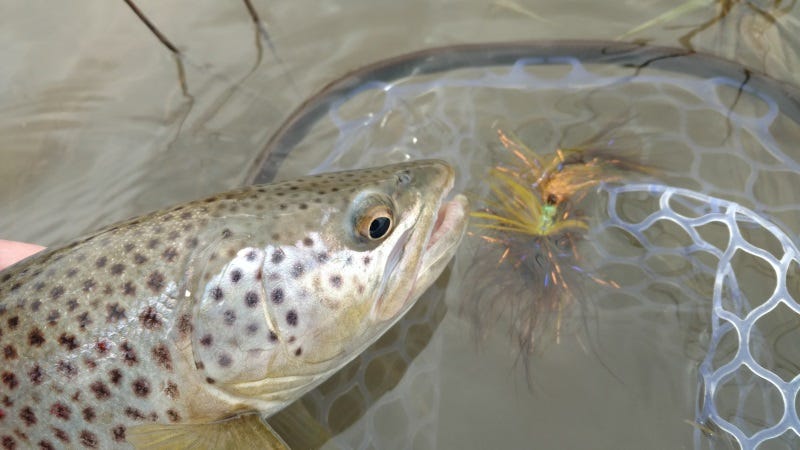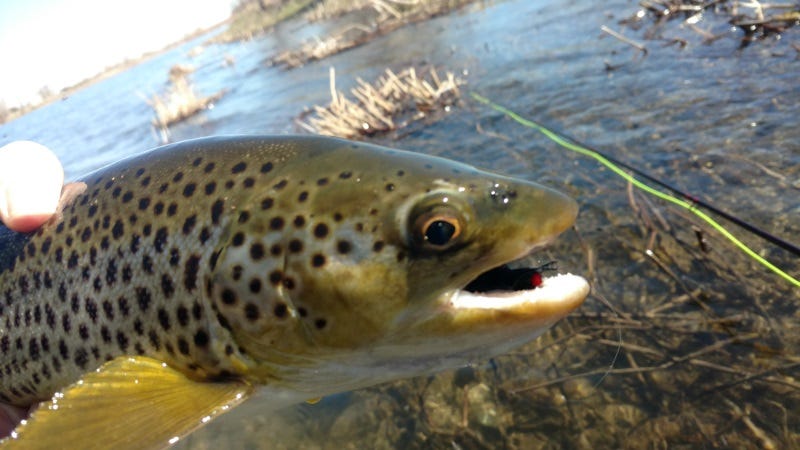High Water Fly Fishing Tactics for Tailwaters aka the Missouri River


It’s that time of year. The lakes are filling, if not already full and the water must be released.
Rivers, streams and small creeks are on the rise and runoff has commenced. We haven’t seen the peak high water flows yet, but expect to see flow continue to rise over the next couple weeks.
Don’t be discouraged by high water, trout still need to eat and are more than willing to, you just need to find them and present your flies correctly. In my experience, concentrated numbers of trout are found resting (and feeding) in the same areas during periods of high water.
If you want to stay off the rivers, here's how to fly fish stillwaters.
If you find one in a particular high water holding spot, there are likely to be more following pursuit. I will be making most of the tactics presented here pertaining mostly to tailwater fisheries, specifically the Missouri River.
These ideas can be applied to freestones as well, but since I personally fish the Missouri River 12 months out of the year, the info presented here is based on my experience with high(er) flows on the Mo’.
Reading Water: Know what Areas to Target when the Water is High
Soft inside bends, eddies and side channels are great areas to start targeting where trout are likely to rest and feed in higher flows. Obviously the most effective, efficient, and safest way to fish high water is from the boat.
On freestones, areas of cover such as log jams, bankside beaver dams, and large mid-current boulders are excellent lies to search for trout. Since the Missouri river has little such structure, we must read the waters apex the get a better understanding of what’s going on beneath.
Casting to soft pockets and scum line eddies at first glance likely seem to be most productive. But not all trout will be holding in these lies. The Missouri River’s prime lies at any given time will include gravel bar ledges and dropout buckets from riffle water transitions to pools. These areas can be found across the river bank to bank and even right in the middle of the river.
Look for 8’ to 10’ deep seam transitions of faster to deep/slower water from the primary and secondary shelf lines parallel to the bank. Find these transition areas by reading the surface water looking for diamond like braided flows adjacent to long flat slick boardroom table sized glides. This indicates sub-surface shelf lines, often hidden to the naked eye by limited water depth clarity. Trout will hold on these deep subsurface seams in higher water just as they would in late summer lower flows.
The key is to not get discouraged or overwhelmed by higher water. Read it just like you would any other time of the year, just know you must present your flies on or near the substrate and smack dab in their feeding lane. This stuff isn’t rocket science, you just need to be keen and keep aware while fishing so these areas don’t pass you by.
Get your nymphs from us online here-- or learn to tie your own variants here.

Flies: Add a Splash of Flash to Dredge up the Hawgs
Add a splash of flash to your nymphs and streamers. I’m sure you’ve heard using dark muted colors in muddy water such as black, brown and olive is best.
On the contrary, don’t be afraid to try bright colors like chartreuse, red, purple, and white with a bit of flash, especially if there is a bit of sun. I’ve had just as much luck, if not more fishing bright flies in high, off color water than darker flies. Using larger attractor nymphs with a bit of flash will likely gain more attention than a drab muted fly.
Examples are Hot Belly PT’s, Purple Prince, Mason’s Peep Show, Frenchie, Weight Fly, Pink Amex, UV Czech, Tungsten Warriors and Steel Worms. Flash in your streamers doesn’t need to be overwhelming, but just enough peak the attention of hungry trout. Lil Kim, Skiddish Smolt, Circus Peanut, Cheech Leech, Mongrel Meat, and Trout Sliders are all great contenders.
When the Water is High & Fast: Go Big or Go Home
Whether you are nymphing or streamer fishing, size up. Leave those size 16s, 18s and 20s in the box for lower water. If you are nymphing, size 10’s and 12’s are the ticket. Even if your fly isn’t matching the "hatch" for the early spring period, it most likely will grab a trout’s attention if properly presented by slapping him in the grill.
Streamers don’t need to be overly gaudy, but anything slightly larger than what you would throw in normal flows is better. Bulk materials such as deer hair, polar fibers, marabou and rabbit push a ton of water. Throw these types of patterns to increase your odds and look for patterns with a rattle built in for an added bonus. Anything to give you an edge on hookup rates is key.
Streamer Specific Tactics for Fly Fishing High Water
From the bank, throw up and across to dead drift through most of the run and then swing and strip upstream near the hang down. Present your fly as a disoriented baitfish appears in high, swift or turbulent water. Small baitfish have a hard time orientating themselves, let alone swimming straight in higher flows.
By dead drifting the streamer, you are presenting an easy meal to the willing trout. He will most likely give chase and eat at the start of the swing or near the hang down. If dead drifting large streamers is not your thing, slow your retrieve WAY down. Long, slow strips are the ticket. Leave those quick jerky strips in your arsenal for middle of summer and fall.
A good tactic from the boat is to cast upstream parallel to the bank and immediately start stripping the fly 4 or 5 times with the speed of the current followed by 3 or 4 seconds of dead drift and repeat. It’s usually on the dead drift or on the following 1st or 2nd strip the trout will hammer your streamer.
This technique puts the fly directly in front of bank hugging trout making it irresistibly hard to pass up. Be ready and hang on since the eat will most likely be a violent affair.

How To Nymph in High Water on the Missouri River
As mentioned above, larger flies are the ticket. Great patterns to fish under an indicator besides attractor nymphs would be patterns like size 6 and 8 woolly buggers, crayfish patterns, pats rubber legs and zirdle bugs.
All these patterns should be dead drifted with extra weight so they are literally bouncing off or near the bottom. Using heavy fluorocarbon is recommended, not only to help get your flies down, but to minimize any risk of abrasion.
The Missouri River in general does not have much in terms of an abrasive substrate, but during higher flows, you never know what debris may decide to tango with your leader. Fluorocarbon is just an added insurance policy. A great technique and benefit to your dead drift is adding large up or downstream mends.
This effect is especially beneficial when fishing small buggers, crayfish and even sculpin patterns. This will imitate the quick darting motions of the natural.
Dry Fly Specific Tactics for Fishing High Water
In my experience, you see tons of bugs at higher flows, but no fish consistently rising to them. You will see random splashy rises here and there but not consistent enough to even blind fish dries throughout your float.
If you do get any dry fly opportunity presented to you, it will most likely be in the few side channels that litter specific areas of the Mo, or in those large number of scum liner eddies. Trout tend to be slightly less weary in higher flows due to less water clarity and will slam a top water morsel with reckless abandon.
This will most likely be the case when you decide to present a dry fly during higher flows. You won’t see sippers like you would during the summer PMD and Trico hatches by any means at higher flows but you might have your best shot in side channels and swirling back eddies. Even if you don’t see any mouths breaking the surface, emerger patterns or sunken dries just under the service can be very effective.
Swirling back eddies are food smorgasbords for trout in high water. Its easy resting water while a conveyor belt of food is constantly being churned about and easy for picking off. Unweighted nymphs and emergers give you a good chance of hooking up in this water, especially under a Palsa float within the first 2 feet of the water column just under the surface.
Patience is the Key to Fly Fishing in High Water
Having patience in high water is a virtue. On tailwaters like the Missouri River, you won’t see numbers of fish like you might on a day in late June, but you will definitely increase your odds of getting into a pig or two if you stick with any of the aforementioned advice.
Fish hard, hold your ground, be relentless and remember to smile and have fun. The payoff is all worth the effort, especially when you are staring that 2 footer in the eye knowing that you fooled him.
If you have any questions about high water fly fishing tactics, use the form below and reach out to us. We will work to get back to you within 24-hours.
